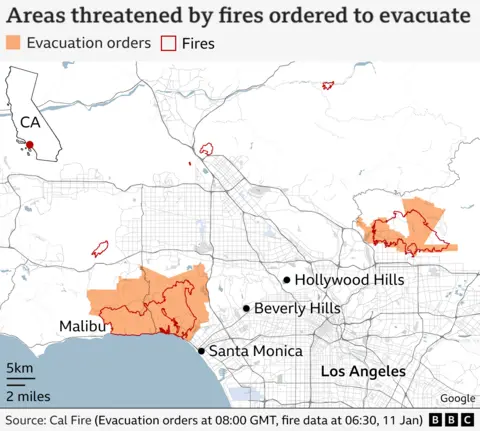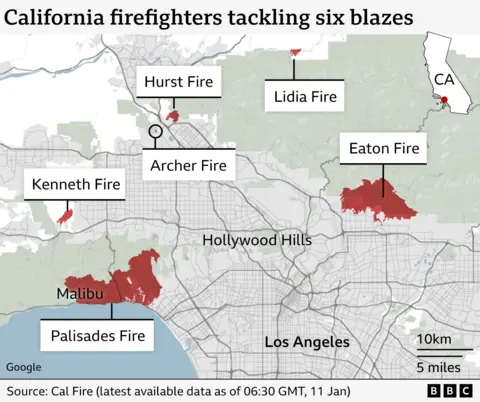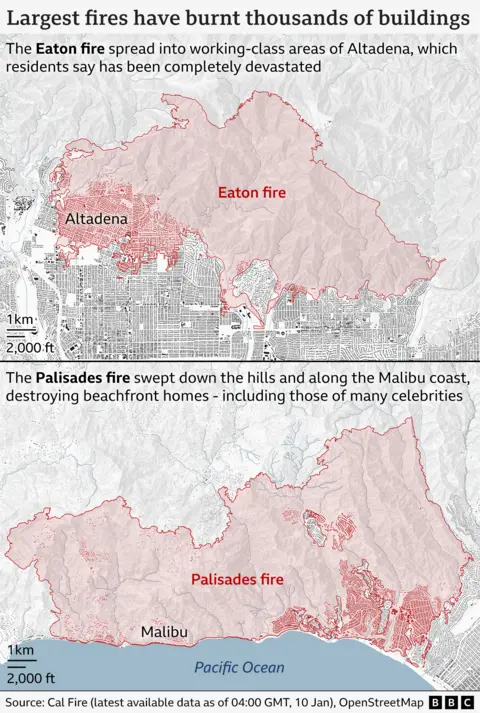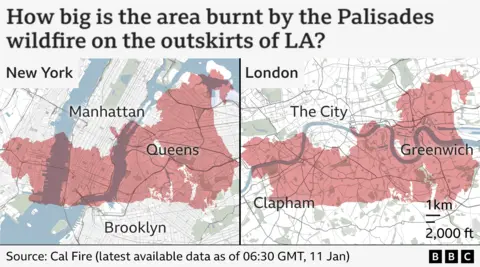Eleven people are dead and 13 others are reported missing as the two largest wildfires ripping across the Los Angeles area remain mostly uncontained.
Firefighters are winning the battle against two other wildfires.
Cadaver dogs and search crews are scouring the scorched rubble of neighbourhoods after the most destructive wildfire in the city’s history.
Residents have been told to stay out of the water on beaches across a swathe of the coastline because of contamination from the fires.
What’s the latest?

The largest fire in the Palisades grew by 1,000 acres overnight, although firefighters made progress in increasing containment.
The fire is moving east, threatening the wealthy neighbourhood of Brentwood, home to the Getty Center, a world-famous art museum that has now been evacuated.
Students at the nearby University of California, Los Angeles are awaiting updates from officials.
Eight deaths have been confirmed in the Eaton fire and another three in the Palisades fire. Officials say they are investigating reports of another 13 people missing.
More than 153,000 people are under evacuation orders in Los Angeles county, according to local authorities, as of Saturday. Another 166,000 are under evacuation warnings.
More than 12,000 structures have been razed by the fires. By structures, officials mean homes, outbuildings, sheds, mobile homes and cars.
More than 7,000 structures have been destroyed by the Eaton fire.
The Palisades fire has destroyed about 5,300 structures, including at least 426 houses.
Authorities say a curfew that is in place from 18:00 local time (02:00 GMT) to 06:00 within the areas affected by the Palisades and Eaton fires after reports of looting is being “strictly enforced”.
There have been 22 arrests – 19 in the Eaton fire area and three in the Palisades fire zone. Two arrests were for curfew violations and these individuals were taken into custody.
The others were held on suspicion of burglary, looting, ID theft, possession of narcotics. One individual was on parole and in possession of a concealed firearm.
About 400 National Guard members are deployed around the region helping with road closures and critical infrastructure missions, say officials.
Insured losses are expected to be above $8bn (£6.5bn) because of the high value of the properties damaged.
Celebrities who have lost their homes include Mel Gibson, Leighton Meester and Adam Brody, who attended the Golden Globes just days ago, and Paris Hilton.
Where are the fires?

There are four fires raging in the wider area, according to California fire officials:
- Palisades: The first fire to erupt on Tuesday and the biggest in the region, which could become the most destructive fire in state history. It has scorched more than 22,660 acres, including the upmarket Pacific Palisades neighbourhood. It was 11% contained as of midday Saturday
- Eaton: It has struck the northern part of Los Angeles, blazing through cities such as Altadena. It is the second biggest fire in the area, burning nearly 14,000 acres. It is 15% contained
- Hurst: Located just north of San Fernando, it began burning on Tuesday night and has grown to 799 acres, and is 76% contained
- Kenneth: This fire broke out on Thursday on the border of Los Angeles and Ventura counties. It so far covers more than 1,052 acres. Authorities say its progress has been stopped and it has been 80% contained, with no structures damaged or destroyed
The earlier Archer, Sunset, Lidia, Woodley and Olivas fires have been contained.
Was LA prepared for the fires?

A political row about the city’s preparedness has erupted after it emerged that some fire crews’ hoses ran dry.
California Governor Gavin Newsom has called for an independent investigation into the loss of water pressure to hydrants and why the Santa Ynez Reservoir was closed for maintenance and empty when the fire broke out.
“Losing supplies from fire hydrants likely impaired the effort to protect some homes and evacuation corridors,” he wrote.
Mayor Karen Bass returned to the city from a previously arranged trip to Ghana to find it on fire. She has faced intense questions about the region’s preparedness, her leadership in this crisis, and the water issues.
Before the fires broke out, the city of LA’s fire chief warned in a memo that budget cuts were hampering the department’s ability to respond to emergencies.
On Saturday, LA County Fire Chief Anthony Marrone separately denied that his department had been unprepared.
“I did everything in my power to make sure that we had enough personnel and resources before the first fire started,” he said.
“It wasn’t for a lack of preparation or decision-making that resulted in this catastrophe. It was a natural disaster,” Marrone added.
Dismay over the fire threat was worsened by alerts mistakenly sent to every mobile phone in Los Angeles on Thursday, residents say, prompting anger from some. About 10 million people live in the county.
During a news conference on Saturday morning, city authorities blamed a software glitch, which they said was “frustrating, unacceptable”. They said they were changing their alerts system to partner with the California state emergency notification system.
What caused the fires?
A combination of an exceptionally dry period – downtown Los Angeles has only received 0.16 inches (0.4cm) of rain since October – and powerful offshore gusts known as the Santa Ana winds have created ripe conditions for wildfires.
Santa Ana winds flow east to west through southern California’s mountains, according to the National Weather Service.
The winds can also be responsible for the scale of destruction that follows.
Blowing across the deserts further inland, they create conditions where humidity drops, which dries out vegetation. If a fire does start, the winds can fan smouldering embers into an inferno in minutes.
Speeds of 60 to 80mph (95-130km/h) are common, but gusts of up to 100mph (160km/h) can occur.
US President Joe Biden said on Friday that while firefighters were “able to partially prevent” some of the fires from spreading, winds would remain a threat until early next week.
Investigations into what initially sparked the fires are continuing.
LA District Attorney Nathan Hochman said that the focus of law enforcement was currently on saving lives and homes and assisting firefighters, but that eventually they would turn towards investigating the causes of the fires.
“If it is determined that there is a man-made and intentional setting of any of the fires involved in this situation, the people who committed this arson will be arrested, they will be prosecuted and they will be punished to the full extent of the law,” he said.
Hochman also warned people against looting and flying drones – one struck a firefighting plane, which was damaged but able to land without any injuries – and warned of scams targeting fire victims.
Arson is not the only cause of deadly wildfires. Power lines and other utility equipment have sparked some of the most destructive blazes in California’s history. In 2018, the so-called Camp Fire destroyed the town of Paradise and killed 85 people, many of whom died in their cars trying to flee.
BBC weather forecaster Sarah Keith-Lucas says there is no rain forecast in the area for at least the next week, so conditions remain ripe for fire.
Although winds were expected to ease slightly later Friday into Saturday, forecasters warned that they would pick up again on Sunday into Monday.
What role has climate change played?
Although strong winds and lack of rain are driving the blazes, experts say climate change is altering the background conditions and increasing the likelihood of such fires.
Much of the western United States including California experienced a decades-long drought that ended just two years ago, making the region vulnerable.
“Whiplash” swings between dry and wet periods in recent years created a massive amount of tinder-dry vegetation that was ready to burn.
US government research is unequivocal in linking climate change to larger and more severe wildfires in the western US.
“Climate change, including increased heat, extended drought, and a thirsty atmosphere, has been a key driver in increasing the risk and extent of wildfires in the western United States,” the National Oceanic and Atmospheric Administration says.
Fire season in southern California is generally thought to stretch from May to October – but the governor has pointed out earlier that blazes had become a perennial issue. “There’s no fire season,” he said. “It’s fire year.”





